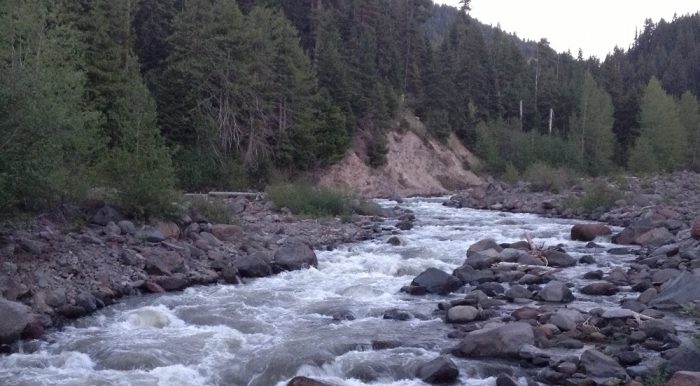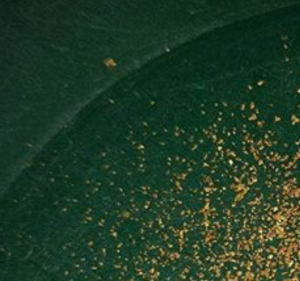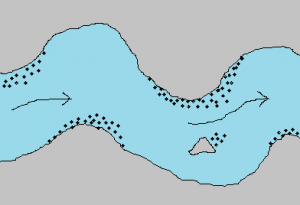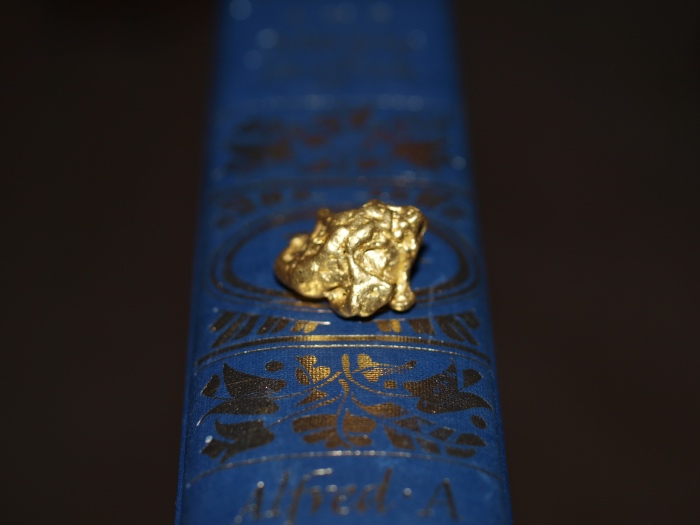
A Scenario: Why Most People Never Find Gold
Here is what most beginners do on their first prospecting trip. Let’s see if this sounds familiar?
You’ve armed yourself with all you need to find some placer gold. You have a gold pan, shovel, pick, snuffer bottle, and a little jar to carry your gold nuggets in. You’ve traveled to the nearest river and you have total confidence that there is gold there to be found.
Walking down to the edge of the water, you spy a nice beach along the edge of the water and scoop some sand and gravels into your gold pan. Panning slowly and carefully, soon your left with just a pinch of small gravels, maybe some black sands, and….. no gold?
You do a little more digging around… come up with a few shiny specks that end up being “fool’s gold.” You head home, toss your gold pan in the garage and give up on your lofty dream of being a gold miner.
Don’t Toss out Your Prospecting Gear!
You were unsuccessful, but don’t give up! There is gold out there to be found.
No doubt, the above scenario has happened to many beginning prospectors who make the mistake of thinking that a rivers have gold scattered throughout. They think all that is needed is a miner with his gold pan to come and gather it all up.
Of course, gold is not evenly distributed throughout a river system, so it is important to understand some basic facts about gold. Let’s take a look at how and why gold is found where it is.
Gold is Heavy!
 Gold has a higher specific gravity than the sands and gravels in the stream, and that makes it somewhat predictable. You need to go down to find it; down below the sands and gravels, and down deep into the cracks and crevices in bedrock.
Gold has a higher specific gravity than the sands and gravels in the stream, and that makes it somewhat predictable. You need to go down to find it; down below the sands and gravels, and down deep into the cracks and crevices in bedrock.
During a high water event, the material in a stream acts in the same way that it does in your gold pan. Everything is being agitated, and the heavier gold is able to travel downward until it hits a major obstruction.
Beginning prospectors commonly make the mistake of not dig deep enough to get to the gold. It may be right below their feet, but it is often covered by significant overburden that contains little or no gold.
Get down to the bedrock if you want to find gold!
Placer Gold Deposits on Bedrock

Placer gold accumulates anywhere that gravity allows it to settle; below waterfall, behind rocks and boulders, or anywhere that the water velocity slows down. Black spots represent areas of gold deposition.
Not only does gold go deep down in the gravel, the gold is also constantly moving downstream until it reaches an obstruction. It may get caught in a deep bedrock crack, but before it settles down to bedrock it has a good chance of moving a significant distance down the stream during a high velocity stream flow.
Once again, it’s weight will cause it to settle in certain predictable areas, places that the stream slows down or loses the energy needed to move the gold any farther. These areas include deep pools beneath waterfalls, behind large rocks and boulders, amongst exposed tree roots, and the inside bends of a stream.
If you are a fisherman, then a good way to spot areas like this is to identify places that fish would naturally congregated. The slack water near the faster current. These are the same general areas that gold will lose momentum and get hung up in bedrock.
An Aerial View of Common Placer Gold Deposition

Gold accumulates in areas where water slows down such as the inside curves of a river or behind large boulders. Aerial view of a river or stream with black spots represent typical gold deposition.
When prospecting for gold, always be on the lookout for black sands. Black sands are composed of various iron oxides, and are commonly associated with placer gold due to their high specific gravity. These black sands will settle out a stream the same way that the gold will, so always be on the lookout for high concentrations of it.
The presence of black sands do not guarantee the presence of gold, but if you are in a gold bearing stream there is a good chance that gold is nearby. If your gold panning is resulting in black sands, mercury, and lead bullets or fishing weight, you are on the right track.
If you are finding gold then you are probably also finding black sand. But if you are finding black sand it does not necessarily mean that you will find gold.
Prospecting in Places that ACTUALLY HAVE GOLD
All of this knowledge is worthless if you don’t apply it in a location that actually has some gold. For the most part, gold mining areas are well-documented now. You don’t need to go out and find a brand new location, most of these places have already been discovered.
You can do everything perfectly, learn to “read the river,” dig in the right spot and do a stellar job of gold panning, but if there isn’t any gold in the areas then you will go home empty handed.
Don’t waste your time in places with no gold. Before you start prospecting you should do some research at home. Find areas that have historic gold mining activity. This will go a long way.

Consistently Finding Gold Isn’t Hard!
This is serious information that any prospector needs to understand if they want to be successful. If you understand how and where gold settles in a river then you will have a good chance of finding some of it.
Let’s put this another way… Gold is predictable! Yes, sometimes you will find gold in areas that are unexpected, but generally speaking you will locate river gold in predictable deposit locations. And this is good news!

Yes, big gold nuggets like this are indeed very rare. But finding small bits of gold within river gravels actually isn’t all that difficult to do! Once you understand the basic principles of how gold deposits form you can easily recover gold IF you are in a gold-bearing area.
Next: How to Use a Metal Detector to Find Gold in Quartz
